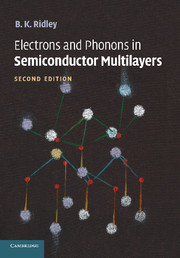Book contents
- Frontmatter
- Contents
- Preface
- Introduction
- 1 Simple Models of the Electron–Phonon Interaction
- 2 Quantum Confinement of Carriers
- 3 Quasi-Continuum Theory of Lattice Vibrations
- 4 Bulk Vibrational Modes in an Isotropic Continuum
- 5 Optical Modes in a Quantum Well
- 6 Superlattice Modes
- 7 Optical Modes in Various Structures
- 8 Electron–Optical Phonon Interaction in a Quantum Well
- 9 Other Scattering Mechanisms
- 10 Quantum Screening
- 11 The Electron Distribution Function
- 12 Spin Relaxation
- 13 Electrons and Phonons in the Wurtzite Lattice
- 14 Nitride Heterostructures
- 15 Terahertz Sources
- Appendix 1 The Polar-Optical Momentum-Relaxation Time in a 2D Degenerate Gas
- Appendix 2 Electron/Polar Optical Phonon Scattering Rates in a Spherical Cosine Band
- References
- Index
14 - Nitride Heterostructures
Published online by Cambridge University Press: 05 September 2009
- Frontmatter
- Contents
- Preface
- Introduction
- 1 Simple Models of the Electron–Phonon Interaction
- 2 Quantum Confinement of Carriers
- 3 Quasi-Continuum Theory of Lattice Vibrations
- 4 Bulk Vibrational Modes in an Isotropic Continuum
- 5 Optical Modes in a Quantum Well
- 6 Superlattice Modes
- 7 Optical Modes in Various Structures
- 8 Electron–Optical Phonon Interaction in a Quantum Well
- 9 Other Scattering Mechanisms
- 10 Quantum Screening
- 11 The Electron Distribution Function
- 12 Spin Relaxation
- 13 Electrons and Phonons in the Wurtzite Lattice
- 14 Nitride Heterostructures
- 15 Terahertz Sources
- Appendix 1 The Polar-Optical Momentum-Relaxation Time in a 2D Degenerate Gas
- Appendix 2 Electron/Polar Optical Phonon Scattering Rates in a Spherical Cosine Band
- References
- Index
Summary
It was a miracle of rare device,
Kubla Khan, Samuel Taylor ColeridgeSingle Heterostructures
In bulk material, neutralization of the enormous electric fields produced by the spontaneous polarization can be achieved by a relatively modest adjustment of the population of surface states. This is no longer possible in the case of inhomogeneous material exhibiting inhomogeneous spontaneous polarization, such as the AlGaN/GaN heterostructure. A layer of AlGaN grown epitaxially on GaN has not only a spontaneous polarization larger than that of GaN but it has, in addition, a piezoelectric polarization associated with the elastic strain inevitably present as a consequence of the lattice mismatch. No straightforward adjustment of the population of the surface states can eliminate the resultant fields. As a result, nitride heterostructures differ uniquely from heterostructures of cubic semiconductors in exhibiting large, built-in electric fields, and these result in the spontaneous formation of a quasi-2D electron gas at the AlGaN/GaN interface. In the cubic case such a gas must be produced by doping, thereby, ineluctably, introducing charged-impurity scattering even when the system is modulation doped. Doping is unnecessary in nitride structures so, in principle, enormous lowtemperature mobilities are possible and will, no doubt, be achieved as growth techniques evolve.
An estimate of the density of the polarization-induced electron population at the AlGaN/GaN interface can be obtained assuming the existence of a common branch-point Fermi energy and simple electrostatics.
- Type
- Chapter
- Information
- Electrons and Phonons in Semiconductor Multilayers , pp. 349 - 368Publisher: Cambridge University PressPrint publication year: 2009

